United Nations has projected that the global population will reach 9.7 billion in the next 25 years, with almost 70% living in urban; it naturally generates an increase in the need for built space to accommodate the growth. In fact, the International Energy Agency estimates that the built area will double by 2050. Going vertical is the most plausible solution in this context. But the need for sustainable solutions is also the need of the hour to combat the effects of climate change, and already many countries are aiming to have 100% net zero carbon buildings and cities by 2050, according to The Paris Agreement, formulated in 2015.
Can our high-rise buildings be sustainable, or is it a lofty paradox? Construction industry professionals have already proven that it is possible and there are many examples to attest to that. Various designers have found different technologies to aid them in achieving sustainable and energy-efficient high-rise buildings.
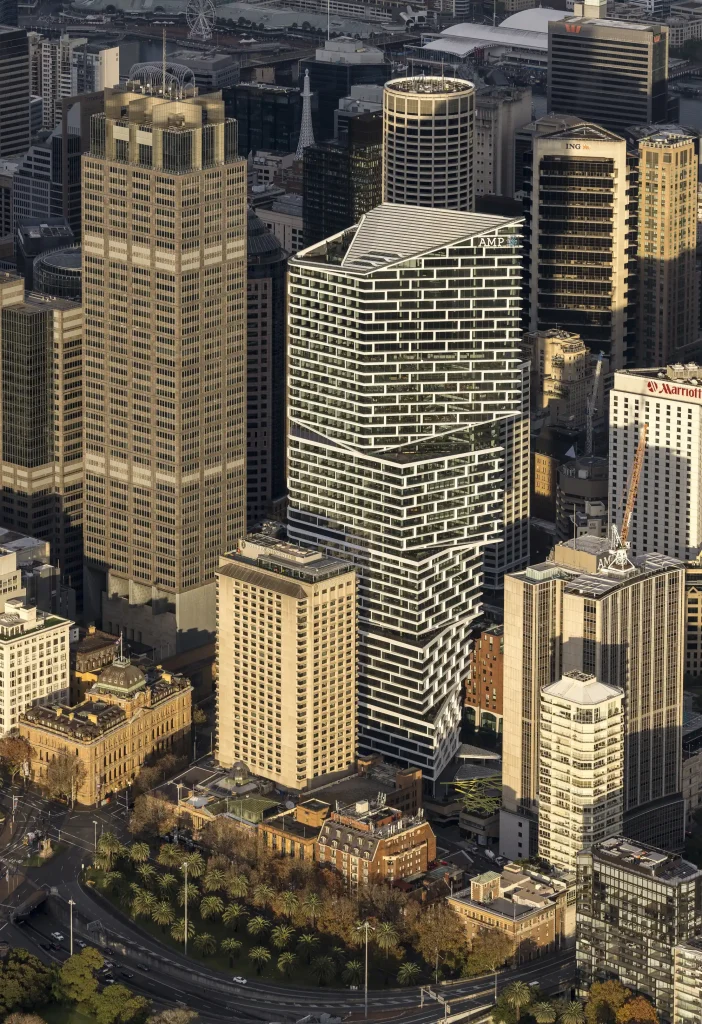
What are high-rise buildings, and how are they advantageous?
According to Brittanica, a high-rise is defined as a multistorey building tall enough to require the use of a system of mechanical vertical transportation like an elevator. This is usually around 35m in height or 12 levels. These can be found to accommodate residences, offices, or commercial spaces like hotels and shops or a combination of two or more functions. A very tall high-rise that is 150m or taller in height is called a skyscraper.
Sustainable design requires the project to be efficient in its energy and water consumption; to foster an environment of physical, emotional, and mental well-being; to be resilient and durable in terms of its design and the materials used; and to be aesthetically pleasing and functionally flexible through its eco-friendly designs. With the climate change scenario shaping up most of the decisions in our lives these days, our need for space should not overlook the need to protect and preserve the environment for future generations. Exploring sustainability when designing high-rise structures can create comprehensive and inclusive designs that are ethical on the one hand but, on the other hand, could be a fusion between architecture, technology, and healthy living.
Going vertical is the future of urban growth that already has its advantages:
- The main advantage is that of providing enough shelter to accommodate the growing population. As cities are becoming denser, going vertical is the most probable solution. 2. As we go higher to accommodate the project’s deliverables, the actual land used is lesser and this can help in cutting down costs on land.
- High-rise buildings make efficient use of limited space and can accommodate various functions within one structure. Many of the amenities are therefore shared which helps to reduce energy consumption on a larger scale. This also helps to facilitate social interaction and community building.
- High-rise structures provide an environment that is free of noise and air pollution, along with better ventilation and views. They also offer a great deal of privacy and well-planned security systems.
- By relieving the ground floor from the built structure, urban sprawl is reduced, and the ground level can be designed to accommodate more open spaces for community activities and protect the natural green, enabling land preservation.
- With height comes better access to natural resources like wind and sun, and these can be tapped to efficiently manage the energy consumption of the built environment, facilitating a sustainable design.
- When commercial spaces are integrated with residential units in the same building, it gives easy access to shops, healthcare facilities, and other businesses, reducing the use of time and energy for travel.
- And lastly, high-rise and skyscraper structures define the skyline of an urban built-up and this can also be designed to create iconic views and vistas.
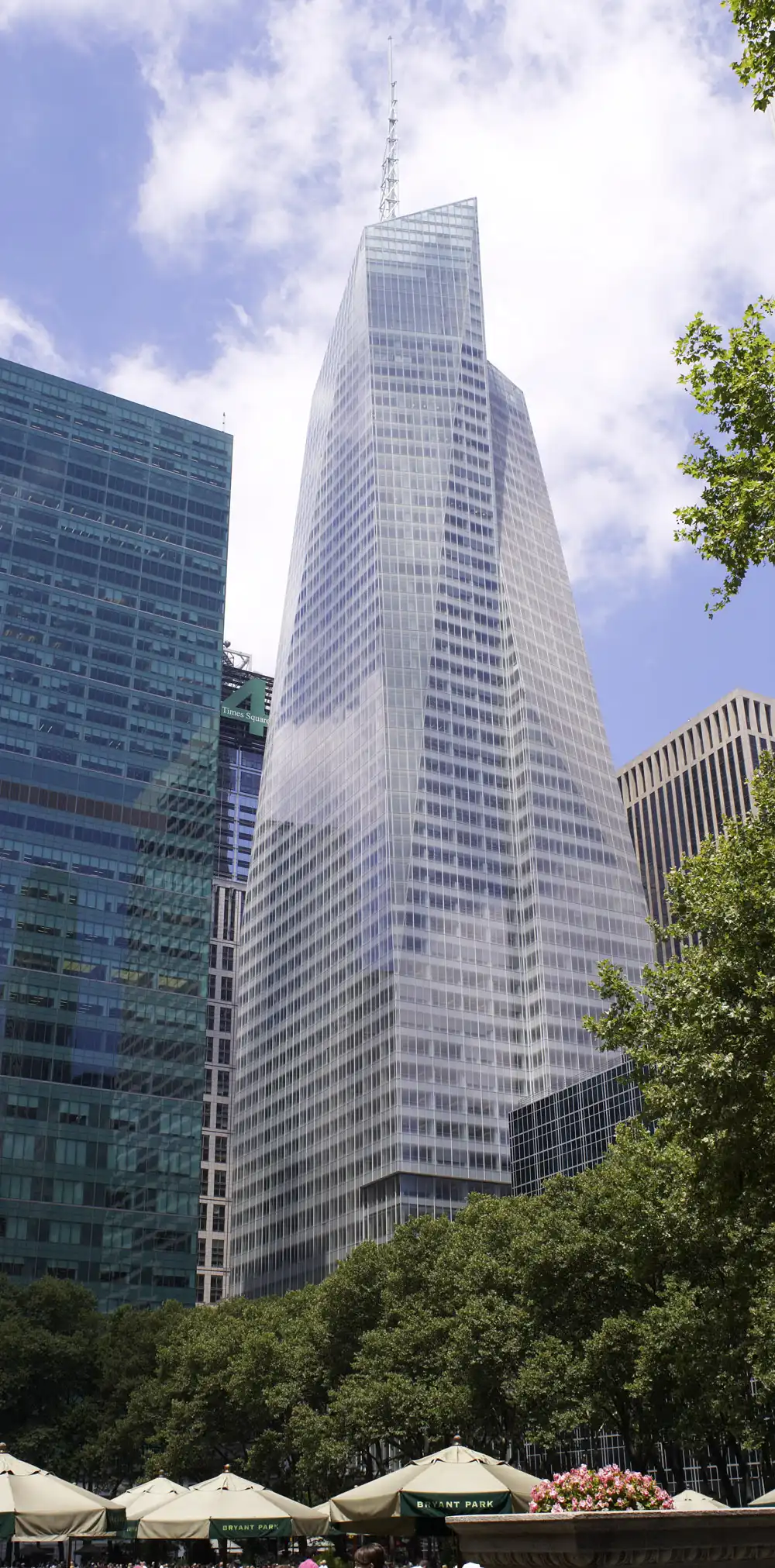
What technologies can create a sustainable environment in high-rise buildings?
Taller buildings need more materials which generates more embodied carbon, and this can be combatted with green and sustainable technologies. When mega structures are improved using better design, engineering, construction, and systems, mega impacts are realized. The improvements include using innovative and advanced materials, efficient technologies in water consumption, façade design, daylighting, and ventilation, using effective mechanical, structural, and electrical infrastructure, and incorporating renewable energy systems.
At the time of design conception, these technology additions need to be incorporated along with aesthetic and functional spatial, landscape, and façade design to enhance the structure with a sustainable environment:
- Smart HVAC systems: In tall structures, a lot of energy gets expended in heating, ventilation, and air conditioning (HVAC) systems. Better design, like the alignment of the structure and its openings, and using smart technology, where real-time data and sensors help to monitor the building use, can help to reduce dependence on these systems.
- Advanced and innovative materials – Materials are the essence of the building and 1need to be sourced sustainably to reduce the impact on the environment. Choosing recycled, reusable, and local materials helps to reduce embodied carbon. There are also many innovative materials that can cater to specific local conditions in terms of insulation, glazing, and facades.
- Energy efficient glass and window technologies – The openings of the buildings are the major sources of bringing in light, heat, and wind and need to be designed according to the need and the surrounding conditions, so dependence on artificial lighting and ventilation can be reduced. Technology today offers a variety of options where heat and light can be reduced or increased depending on the comfort required in the internal environment.
- Building management systems – To manage larger areas, comprehensive management systems are required to control HVAC, lighting, security, mechanical, electrical, water, and plumbing. Energy-efficient systems can be incorporated to ensure precise amounts of energy are used and energy wastage is reduced. Since these systems are shared among a larger number of units, it presents an optimized use of energy.
- Renewable energy integration – The advantage of height for these structures allows greater potential to leverage solar and wind energy. Installing solar panels and wind turbines on the roofs of high-rise buildings can generate a portion of the energy required for the use of the structure. Building integrated photovoltaic cells along the façade and glazing can also help to generate energy to power the structure. These can also be designed to aesthetically enhance the design.
- 6. LED lighting and daylighting – LED lights are known to be more environmentally friendly, energy efficient, and last for much longer than traditional lighting, making them more sustainable. Applying proper daylighting strategies like window and skylight placement and designing open spaces that help to bring in light can help to reduce the use of artificial lighting during the day. These approaches are part of green technology that can enable the building to reduce energy consumption and energy wastage.
- Water efficiency technology – Water is one of the most vital for life to exist. Using water efficiently can help conserve them. Features like recycling used water, rainwater harvesting, efficient plumbing systems and smart technologies can help to conserve and provide clean water for use.
Examples of sustainable and energy-efficient high-rise buildings
1. Commerzbank Headquarters, Frankfurt – Foster + Partners
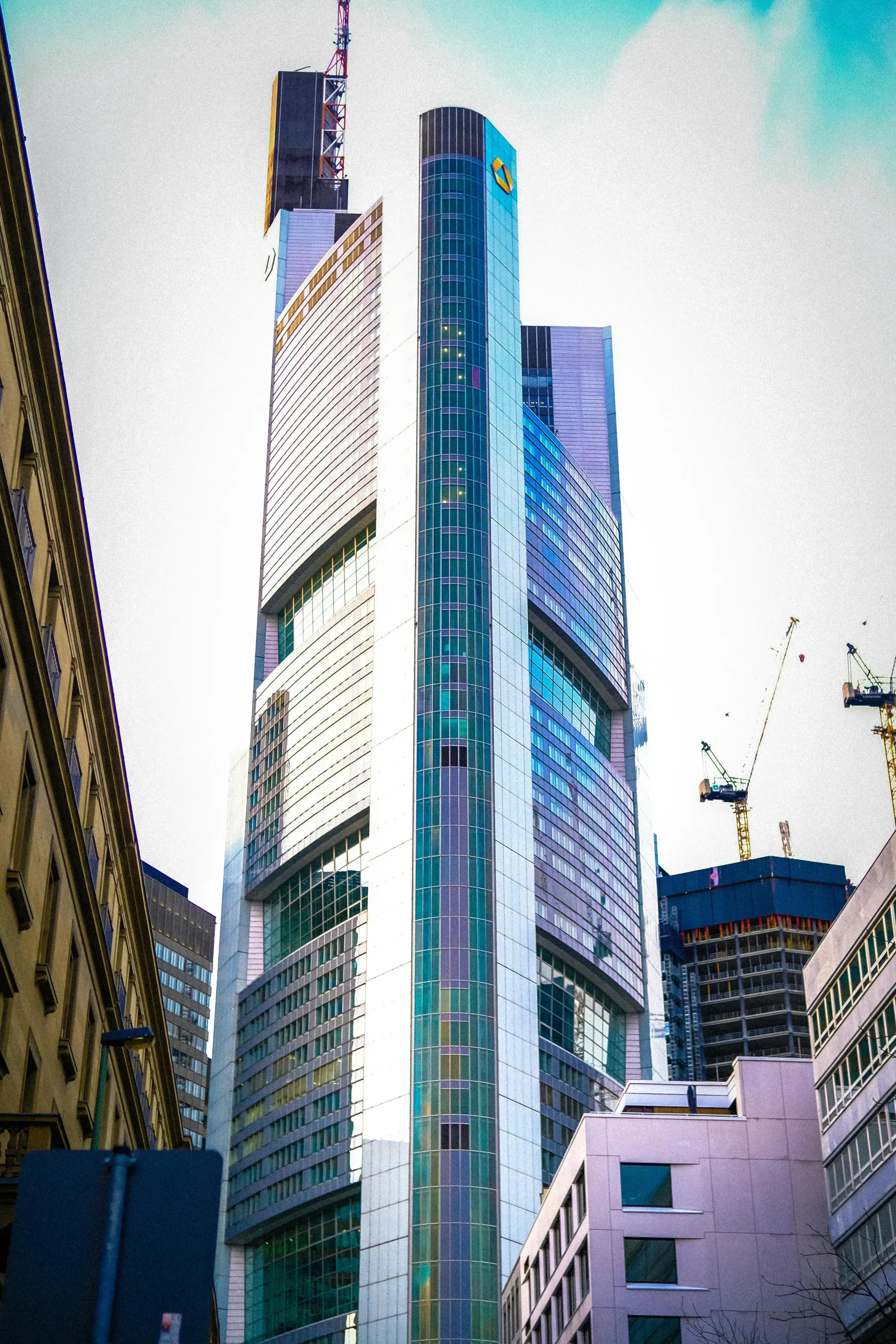
This was once the tallest building in the whole of Europe and was recognized as the first ecological office tower globally. The building centered its design on leveraging natural systems of lighting and ventilation, and even today, the offices are naturally ventilated for 85% of the year. The central atrium is a nature haven that not only provides ventilation and views but also serves as a gathering space.
2. Lotte World Tower, Seoul – KGF Architects
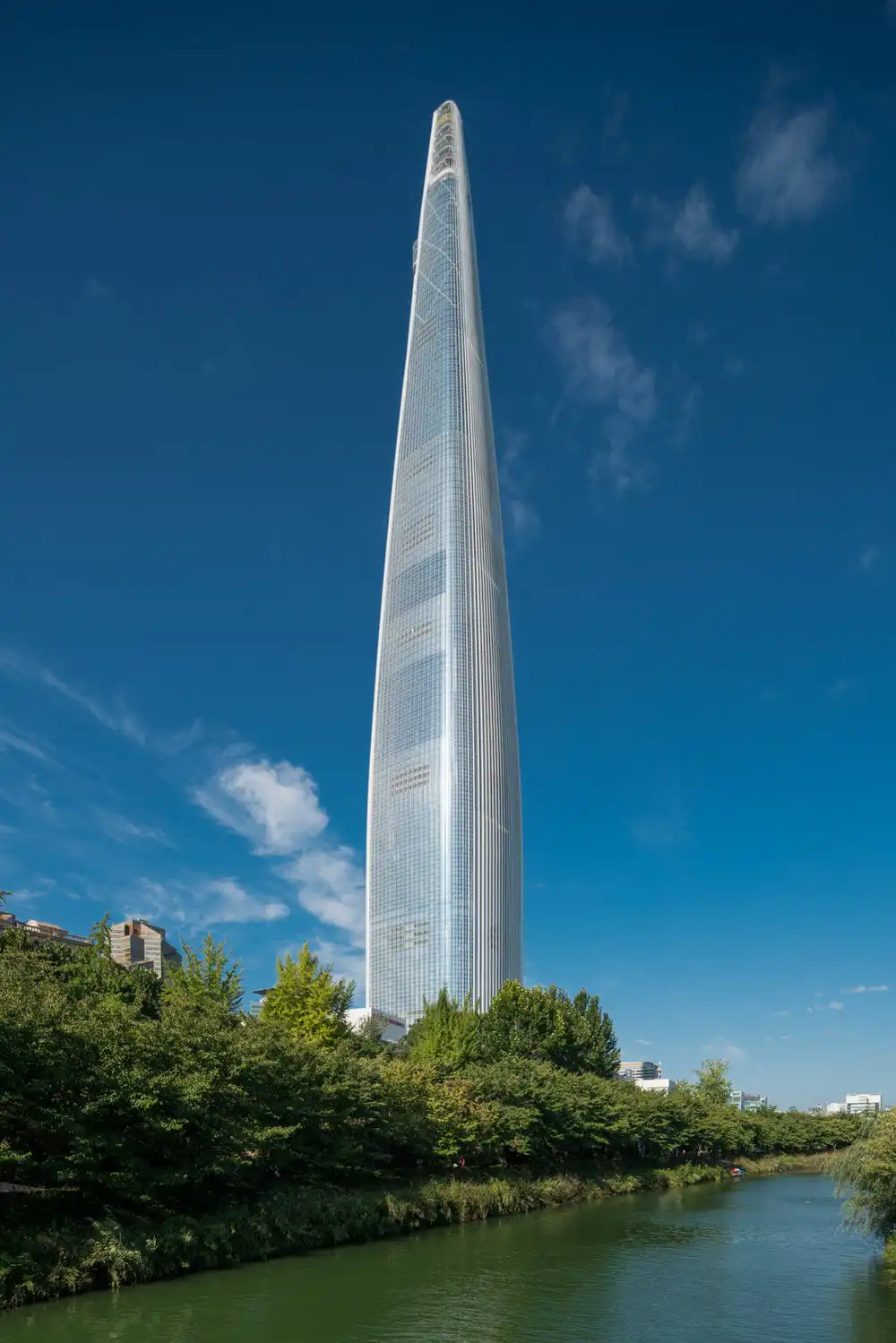
This is another skyscraper that has achieved the LEED Gold Certification, where photovoltaic panels, wind turbines, and geothermal energy form the core of the power of the building and define the commitment to sustainability. Standing at 123 story height, the building contains mixed-use spaces and is cladded with glass and shading devices that allow for natural daylight without heat. Energy recovery wheels are placed on the outside air units that collect exhaust air, and the HVAC system operates with efficiency, and the water harvesting system and reuse of wastewater help to conserve water.
3. National Commercial Bank, Saudi Arabia – Skidmore, Owings and Merrill

Located in the deserts of Saudi Arabia, this 27-storey high-rise is like a solid block of stone in a V-shape, which protects the interiors from the harsh sun and wind. With huge punctures that allow light and ventilation into the landscaped courtyards, the office spaces are inwardly oriented to look toward the courtyards for natural daylighting and ventilation. These two features are an ode to the traditional Islamic style of architecture, where inward orientation and natural ventilation are key features. The office spaces are staggered to optimize the best views and natural ventilation from the courtyards that function as outdoor gardens.
4. Oasia Hotel, Singapore – WOHA
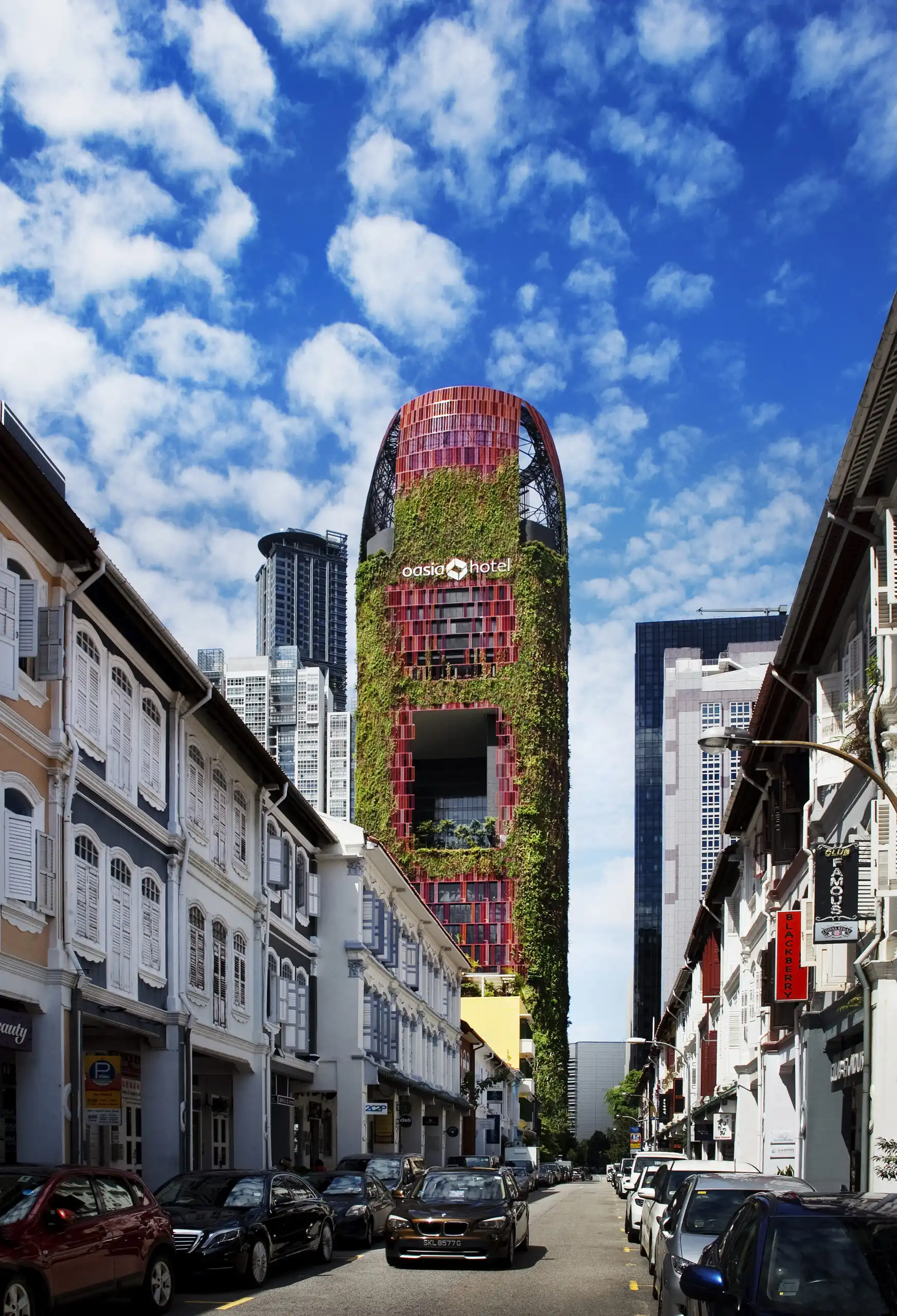
Situated amongst the offices of the Central Business District in Singapore, this hotel is iconic owing to its color, perforations, and greenery along the long, tall structure. By going vertical, the architects were able to create internal views using biophilic designs that not only concentrated on the four sky terraces but also crept out to cover the exterior façade of the whole high-rise. The sky terraces, apart from creating relief along the façade, help to provide natural ventilation, cross-ventilation, daylight, and communal spaces. The greenery found all over the building façade helps to lower the temperature inside by providing shade and absorbing external heat, creating better indoor air quality.
5. One Central Park, Sydney – Ateliers Jean Nouvel

When Central Park takes over a building vertically, it creates a tall visual treat of lush green over glass facades, highlighting how the building can co-exist in harmony with the natural world. These green walls use hydroponics to grow plants, which also facilitates the blocking of sun rays, wind, and noise. Harvested rainwater and recycled used water are supplied for irrigation and consumption and further the project’s brief to be a self-sufficient design. The structure itself embraces natural ventilation and daylighting during the day and LED lighting during the night, keeping the electricity consumption low. The design also incorporated recycled and reused materials in its construction helping to reduce carbon emissions and construction waste.
6. Shenzhen Energy Mansion, China – Bjarke Ingel Group (BIG)
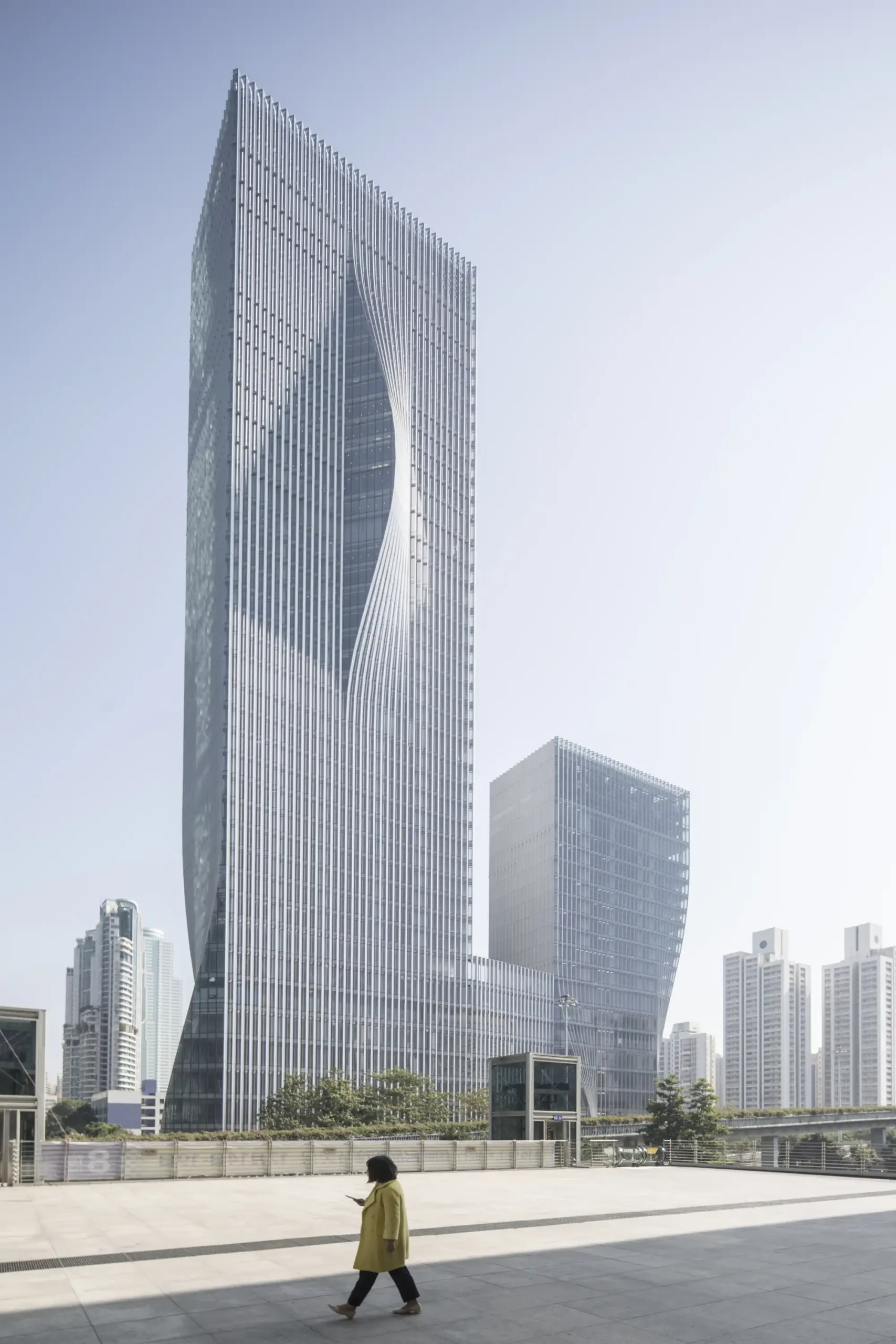
This high-rise building focuses mainly on the passive design of its external envelope to achieve its sustainability goals. With a simple design based on which side each façade faces, the architects were able to create the external façade without employing any technology to leverage the natural resources of light and ventilation. Maximizing openings on the north-facing façade helped to bring in natural light and views without the heat, and the rest comprised closed and open parts forming a pleated envelope to provide insulation and views, respectively. The building is a LEED Gold Certified structure that uses effective lighting and gray water recycling systems.
7. Taipei 101, Taiwan – CY Lee and CP Wang
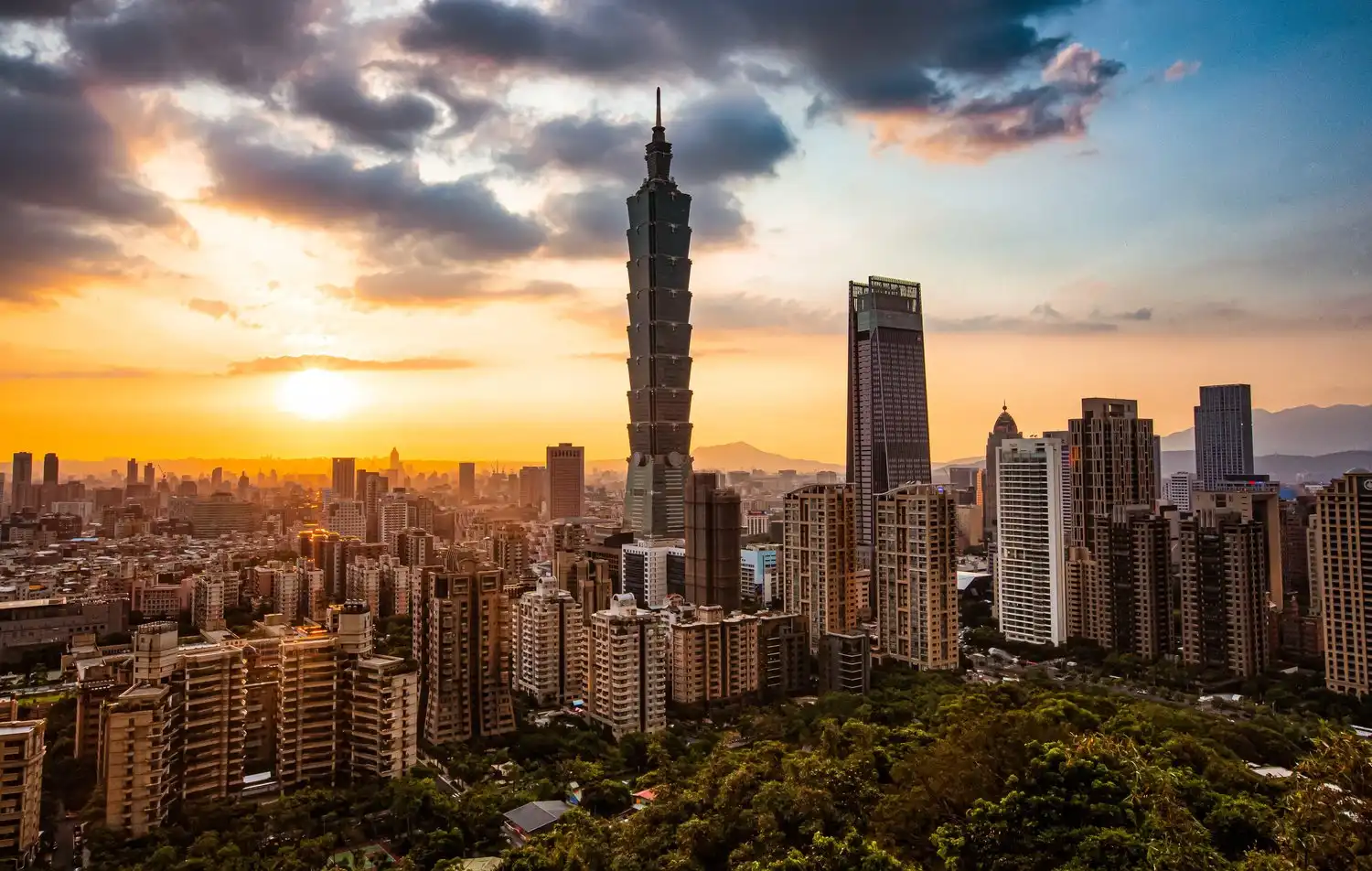
Standing at 101 storey height, this LEED Platinum certified high-rise has been able to save big on water and energy by utilizing Energy Management and Control Systems and was able to achieve the WELL Standard certification too. The building also uses recycled construction materials and green roofs that insulate the building and improve the air quality. The lighting system is energy efficient, and water-saving features enable water conservation.
8. The Duke Apartment, Vancouver – Acton Ostry Architects
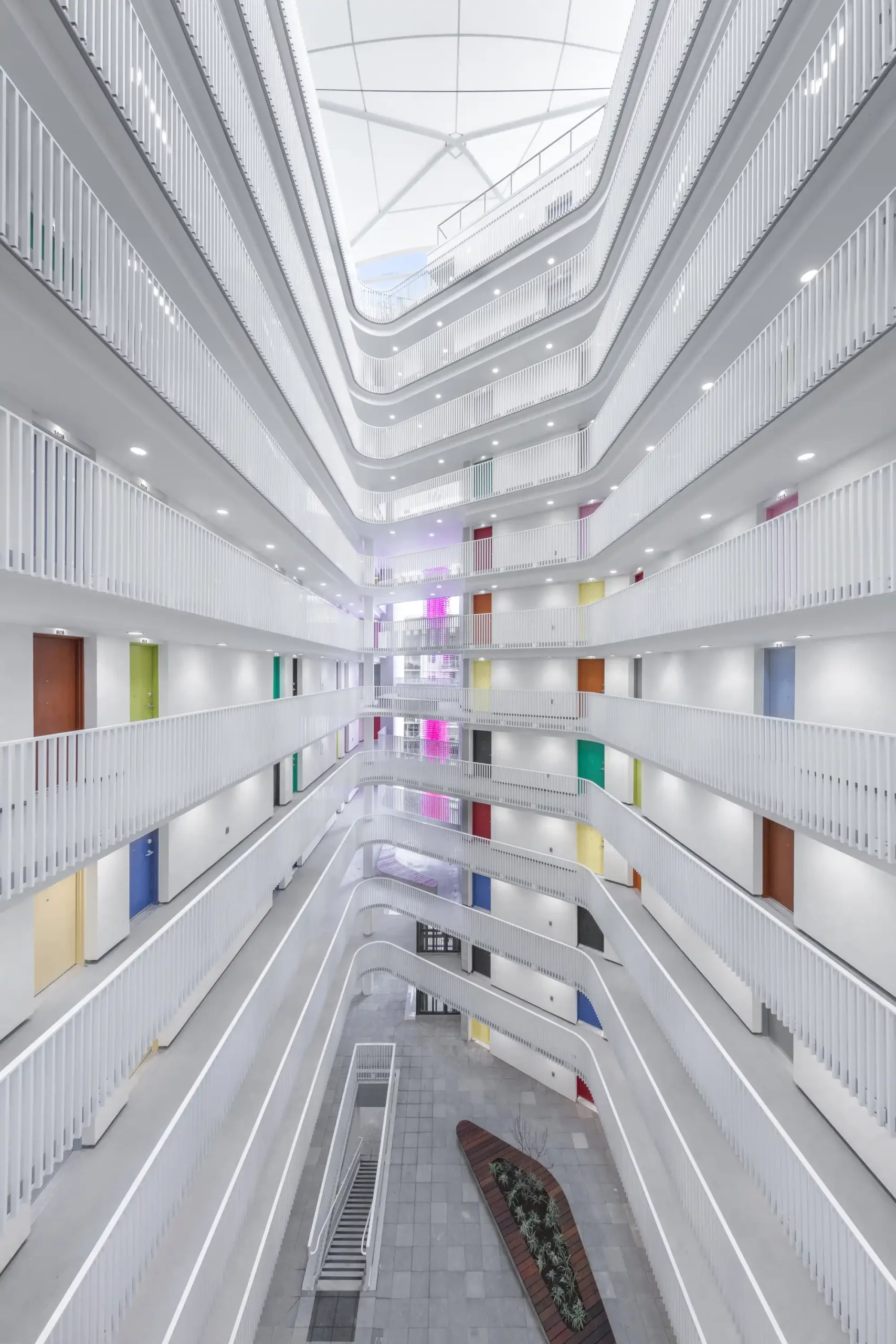
With a big trapezoidal atrium, this mixed-use structure takes in light and ventilation from the central atrium. The apartment is, therefore, well-lit with ample ventilation, and the atrium encourages communal gathering and offers an appealing and animated view of differently colored doors. This affordable housing structure received the LEED Gold certification and features enhanced energy efficiency, water conservation systems, and recycled and environment-friendly materials.
9. The Visionaire Tower, NYC – Pelli Clarke & Partners
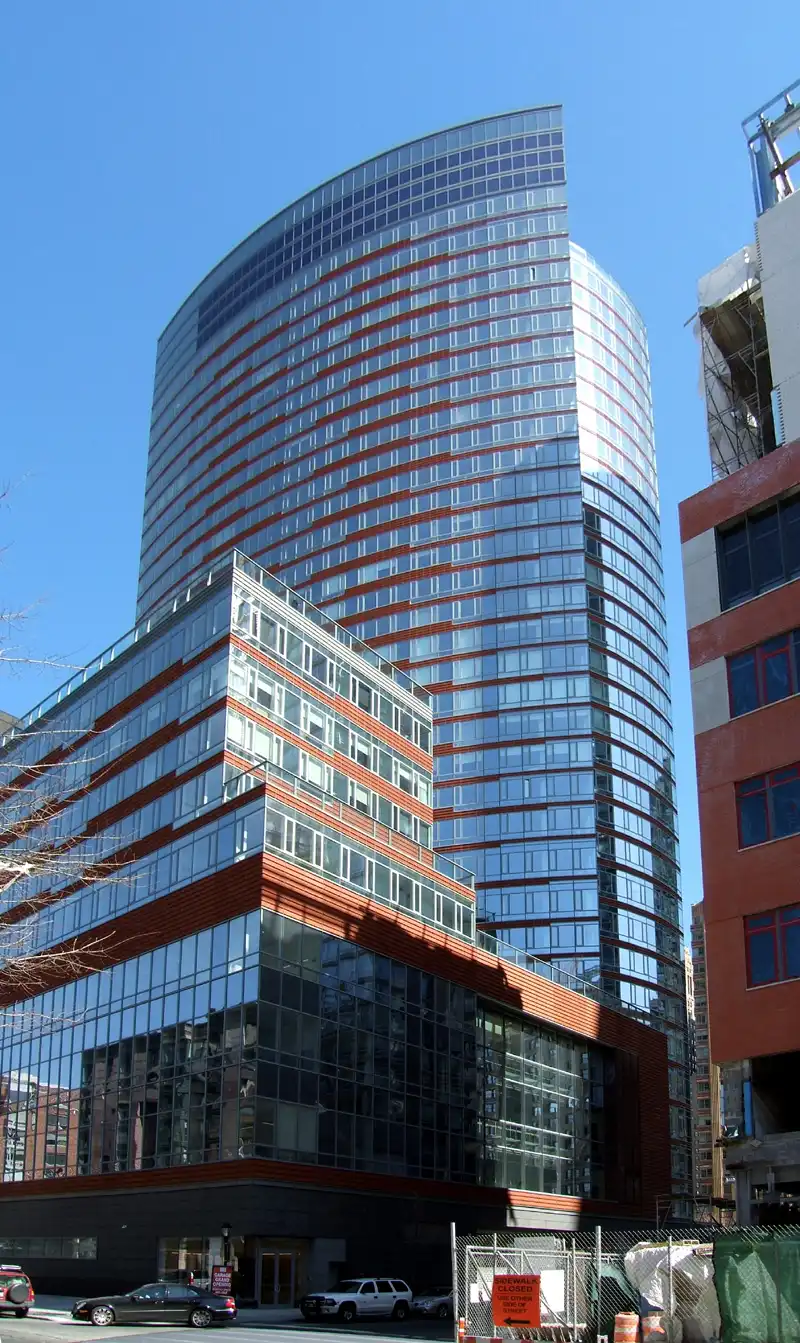
The Visionaire was the first high-rise condominium to receive the LEED Platinum certification on the East Coast of the United States. The structure imitates the Hudson River boundary allowing for maximum views towards the river and the adjoining harbour. The form also optimizes the daylight and natural ventilation well into the depth of the interior, and the exterior façade’s high-performance glass reduces solar gain.
The project has recycled 80% of its construction waste and has also incorporated systems to recycle 100% of the wastewater. The project integrates photovoltaic panels along this façade and a cooling system that maintains a comfortable indoor air quality.
10. 8 Bishopsgate, London – Wilkinson Eyre Architects
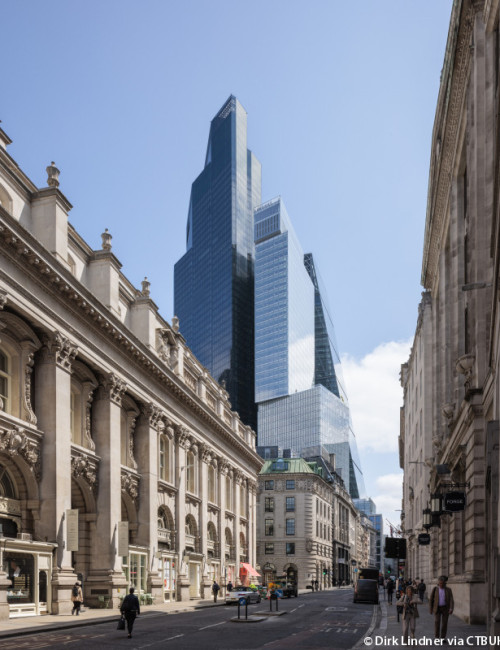
This tower is the tallest structure to be awarded the BREEAM certification through its holistic approach toward sustainable design. It features smart technologies that share real-time data that also helps to tailor energy and comfort levels to each space. The facades have been utilized to incorporate light-responsive blinds, and the roofs have been employed for urban planting or solar paneling. Rainwater is harvested, and the used water is filtered and reused to reduce the dependence on freshwater
Now Stay Ahead with PAACADEMY
Check out the workshops at PAACADEMY-these are a good way to get your hands on the latest digital design tools. The industry experts leading the sessions are here to help you keep your edge sharp and inspired in this ever-changing field.


















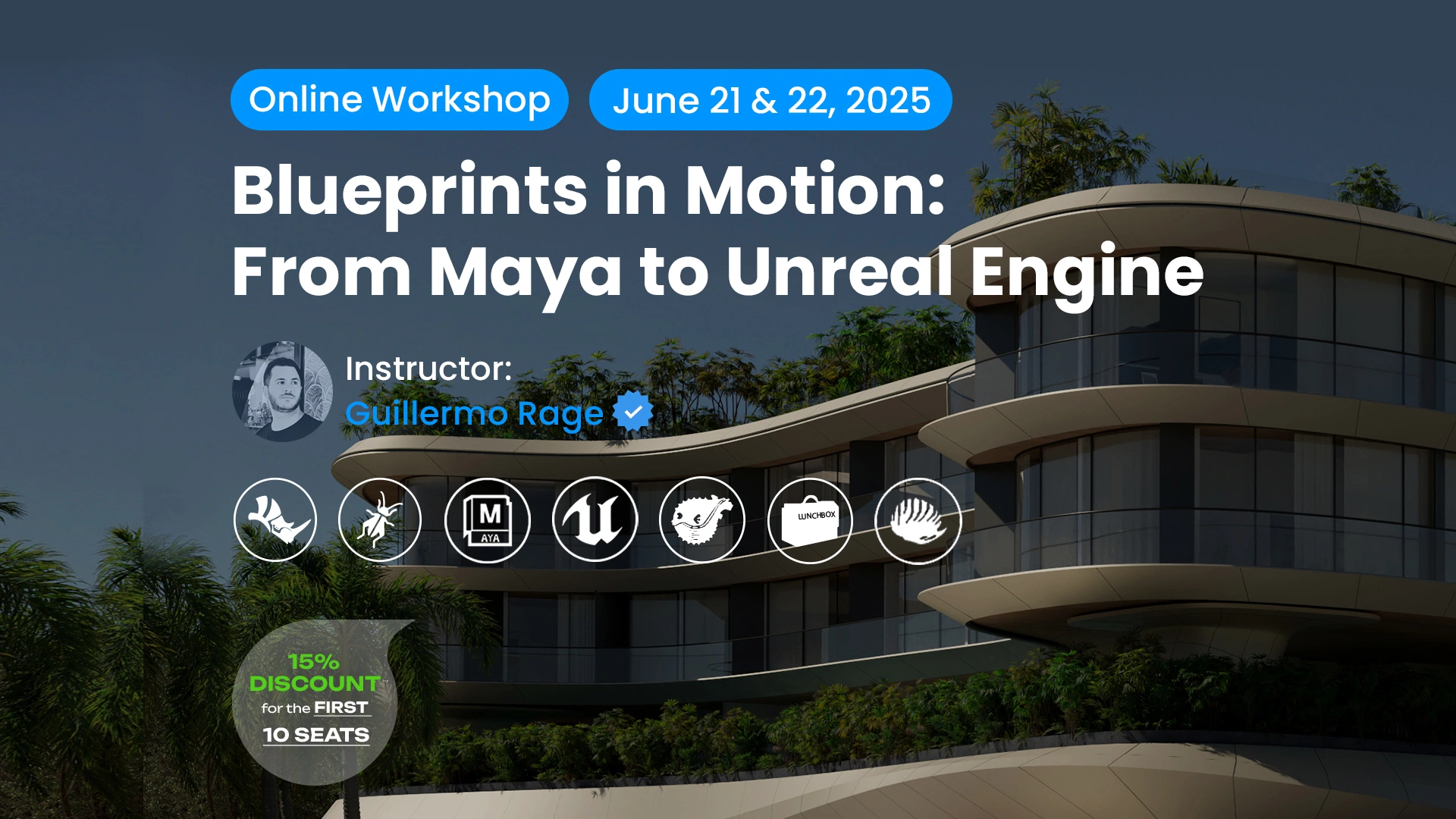
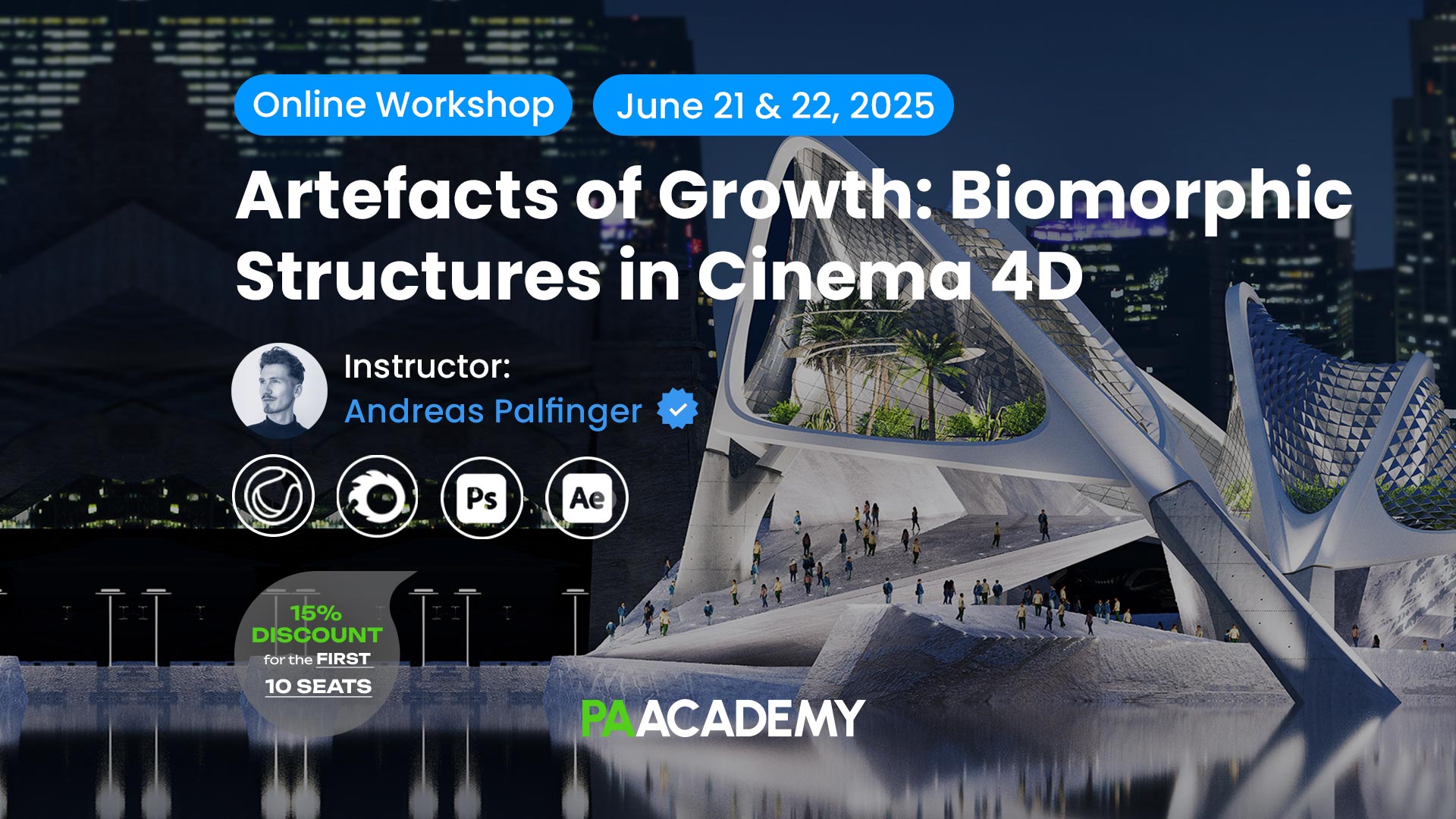











Leave a comment